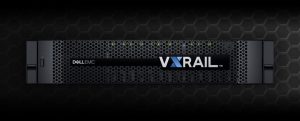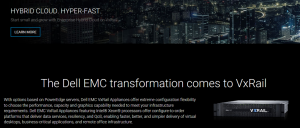
The decision to modernize an IT environment is not solely related to technology – it has a significant impact to people, processes, and ultimately the business. As we speak to different customers, we’re often finding that the right path to IT transformation varies greatly by organization, with many at different stages, using different approaches and with varying long-term goals and objectives – which is precisely why there is no one size fits all approach to IT modernization.
 We recognize our customers are in different states of IT readiness and priorities, which is why we offer a broad portfolio of options spanning complete turnkey hybrid cloud platforms to individual hyper-converged infrastructure (HCI) appliances and nodes. Turnkey hybrid cloud platforms, based on Dell EMC VxRail Appliances, VxRack Systems or VxBlock systems running VMware software, allow us to deliver accelerated deployments, simplified lifecycle management, and streamlined support. If your strategy is focused on modernizing your infrastructure, our fully integrated HCI is the best way to go. We strive to simplify the complex task of transformation and ultimately enable your organization to deliver value to the business faster.
We recognize our customers are in different states of IT readiness and priorities, which is why we offer a broad portfolio of options spanning complete turnkey hybrid cloud platforms to individual hyper-converged infrastructure (HCI) appliances and nodes. Turnkey hybrid cloud platforms, based on Dell EMC VxRail Appliances, VxRack Systems or VxBlock systems running VMware software, allow us to deliver accelerated deployments, simplified lifecycle management, and streamlined support. If your strategy is focused on modernizing your infrastructure, our fully integrated HCI is the best way to go. We strive to simplify the complex task of transformation and ultimately enable your organization to deliver value to the business faster.
With that in mind, our latest enhancements to the Dell EMC portfolio are designed to help our customers advance their priorities with an approach that makes sense for their business. Both the Dell EMC Enterprise Hybrid Cloud (EHC) and Dell EMC Native Hybrid Cloud (NHC) software stacks run across a common base of Dell EMC hyper-converged infrastructure. These turnkey hybrid cloud platforms both provide faster time to value and reduced operational risk for customers looking to deliver cloud-like services on-premises.
The latest release to Dell EMC EHC updates the majority of Dell EMC and VMware core software components in addition to making Dell EHC available now on VxRack SDDC. EHC, deployed on either VxRack Systems or VxRail Appliances, is the best way to stand up an on-premises hybrid cloud based on a tightly integrated VMware software stack. With this release, we’ve not only expanded multi-site capabilities across the Dell EMC EHC portfolio; we’ve added application and VM-level disaster recovery and automated the upgrade process.
 With customized services from Dell EMC, we can help your organization assess and classify your applications and where they’re best suited to run – in the public, private cloud or on modernized infrastructure. With a thorough assessment you can determine which apps to retire, which to move to HCI and which should be refactored using agile, continuously delivery, and container-based architectures.
With customized services from Dell EMC, we can help your organization assess and classify your applications and where they’re best suited to run – in the public, private cloud or on modernized infrastructure. With a thorough assessment you can determine which apps to retire, which to move to HCI and which should be refactored using agile, continuously delivery, and container-based architectures.
For those seeking to embrace digital business models using cloud-native applications, the Dell EMC NHC platform built on VxRail is simply the best way to deploy the Pivotal Cloud Foundry platform-as-a-service (PaaS) environment on-premises. You can run your applications on-premises and extend them seamless into the public cloud. Our latest update to this platform makes it even easier to manage the platform and applications on a global scale with built in high availability.
We also want to make it simpler for a broader swath of organizations to deploy hybrid cloud capabilities for those seeking a “do-it-yourself” approach. To that end, we’re now working to add VMware Ready Systems from Dell EMC to the portfolio by the end of this year. These Ready Systems address the needs of customers wanting the simplicity of deploying a hybrid cloud strategy on HCI while taking on more of the deployment, configuration and lifecycle maintenance responsibility themselves.
The VMware Ready System from Dell EMC combines VMware Cloud Foundation and vRealize Suite with pre-configured and tested configurations of VxRack SDDC and VxRail. Optional fixed price services will be offered for those customers who prefer to have Dell EMC handle the initial deployment. Designed for customers and deployments of any size, they offer quick, easy and low-risk deployments with a lower capital investment than with the turnkey lifecycle and single support model of EHC and NHC.
Organizations of all sizes are already benefiting from their investments in our broad portfolio of HCI offerings. Those IT organizations have already discovered that deployments are not only simpler while reducing install and upgrade admin costs by as much as 16X.
IT organizations can opt to either to start small and scale over time as you move applications to a more modernized infrastructure; VxRail appliances have introduced advanced tools that automate a wide variety of management tasks for even greater efficiencies. But if they prefer a rack-scale HCI system built on the most highly integrated VMware software stack, pre-loaded with VMware Cloud Foundation software, VxRack SDDC is the way to go.
Public clouds are often seen as the big easy button, and, for the right applications and use cases, they can be. But like most things in life, platform choices are never that simple. In fact, a new survey published by 451 Research on behalf of VMware shows that 41 percent of 150 IT decision-makers are running their own private clouds at lower unit costs than a public cloud service. And while costs play a role, location matters when it comes to control and security for some applications and use cases. IDC’s study The Power of Hybrid Cloud found over a 5 year period, a good guideline for applications with predictable and relatively consistent usage tend to be more cost effective on private clouds, while those with variable or unknown usage tend to be more cost effective on the public cloud.
That doesn’t mean that public clouds don’t have a significant role to play in the enterprise. But it does indicate that private clouds running on-premises are here to stay and that arguably a public cloud will simply become a natural extension of a private cloud running in your local data center. In the meantime, wherever your organization is in your quest to transform delivery of your IT services, no one is better prepared than Dell EMC to support your organization both now and well into the future.